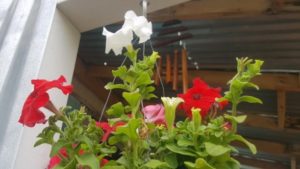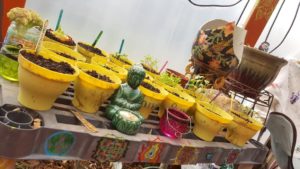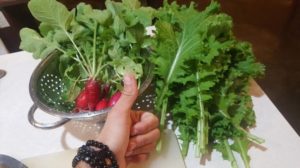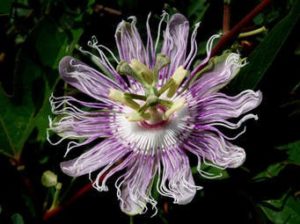Art in Bloom! The Magic and Science of Gardening
By Jordan Wallace
 Gardening can be many things. Most people find puttering around in their gardens therapeutic, others do it for the aesthetic beauty. Some do it to be self-sustained or even to just grow produce to save money at the grocery store. Why do you want to garden? There is a complex plant world out there and we are a part of it. By being observant and paying attention to our plants we can be guided by them in innumerable ways.
Gardening can be many things. Most people find puttering around in their gardens therapeutic, others do it for the aesthetic beauty. Some do it to be self-sustained or even to just grow produce to save money at the grocery store. Why do you want to garden? There is a complex plant world out there and we are a part of it. By being observant and paying attention to our plants we can be guided by them in innumerable ways.
“Location, Location, Location!”
 I always start my plants in pots so they can tell me if they are happy where I have placed them in the yard. It takes time. Occasionally, a plant looks happy only to be fried to a crisp in the bright afternoon sun a few hours later. At this point the plant can be “rescued and relocated” as I like to say. That is when having it in some form of container becomes invaluable. There are many signs a plant will display if they are receiving too much/too little sun. Blackened edges and wilting point towards too much sunshine while pale leaves and lack of growth depict not enough. Each plant is different so careful research on individual species is important.
I always start my plants in pots so they can tell me if they are happy where I have placed them in the yard. It takes time. Occasionally, a plant looks happy only to be fried to a crisp in the bright afternoon sun a few hours later. At this point the plant can be “rescued and relocated” as I like to say. That is when having it in some form of container becomes invaluable. There are many signs a plant will display if they are receiving too much/too little sun. Blackened edges and wilting point towards too much sunshine while pale leaves and lack of growth depict not enough. Each plant is different so careful research on individual species is important.
Timing
 “Timing is everything!” Luckily, we live in Texas and our growing seasons are among the longest in the nation. Due to our semi-equator-like climate in Central Texas you can almost plant year-round! In fact, with a greenhouse you can indeed plant whatever you want, whenever you want. Never limit yourself; it is always worth a shot! I had fresh mustard greens, cabbage, spinach, beets, radishes and every kind of herb you can think of growing this past December. With the spring rains fast approaching this is actually the ideal time to plant. Go get dirty!
“Timing is everything!” Luckily, we live in Texas and our growing seasons are among the longest in the nation. Due to our semi-equator-like climate in Central Texas you can almost plant year-round! In fact, with a greenhouse you can indeed plant whatever you want, whenever you want. Never limit yourself; it is always worth a shot! I had fresh mustard greens, cabbage, spinach, beets, radishes and every kind of herb you can think of growing this past December. With the spring rains fast approaching this is actually the ideal time to plant. Go get dirty!
Spacing
 It is also important to look to your plant’s future. Is it a vine? Does it need space to climb or does it prefer to cover the ground? How big will it get? Will it create shade for other plants? I will never forget when I planted my Passion Vine in the ground beneath my favorite tree. It shot up, climbing and covering the 30 foot tree in less than a month! Beautiful blossoms and a pleasant surprise for me but some would consider that invasive and undesirable. It really depends on your own preferences and the amount of space you have to utilize. Many variations of climbing flowers and vegetables exist for those with limited space. You may consider lattice, trellises and strategically planting near railings or other structures to maximize space and give your plants room to flourish. This is called Vertical planting and deserves an article all unto itself.
It is also important to look to your plant’s future. Is it a vine? Does it need space to climb or does it prefer to cover the ground? How big will it get? Will it create shade for other plants? I will never forget when I planted my Passion Vine in the ground beneath my favorite tree. It shot up, climbing and covering the 30 foot tree in less than a month! Beautiful blossoms and a pleasant surprise for me but some would consider that invasive and undesirable. It really depends on your own preferences and the amount of space you have to utilize. Many variations of climbing flowers and vegetables exist for those with limited space. You may consider lattice, trellises and strategically planting near railings or other structures to maximize space and give your plants room to flourish. This is called Vertical planting and deserves an article all unto itself.
Stagger Planting
At this point, stagger planting is worth mentioning for the serious gardener. Stagger planting is essentially just separating sowing sessions by a few weeks so you can harvest for an extended period and always have fresh produce at your fingertips. For instance, I planted 1 row of corn, tomatoes and beans each (among other veggies but these are what my family eats the most of). I carefully left room for additional rows to be added at later dates. In a few weeks I will plant another row of each and a few weeks after that I will plant another row of each. Thus, successfully ensuring continued harvest through the season for my small family, some for preserves and salsa, some for the “critters” as they take their due and also, enough to share with friends and occasionally, to sell.
Coupling
When planting vegetables and herbs it is good to note that some plants have preferences about who their neighbors are, just as people do. Beans and tomatoes grow well together because the nutrients they claim from the ground are opposite of one another. This means they complement one another rather than competing. (Just be sure your bean vines do not wrap their hands around your tomato stalks, give them a pole to climb instead and guide them up that).
Plant Care
A lot of people think gardening takes a lot of effort, but that all depends on how you define “effort”. I have a zealous determination for growing every kind of plant I can get my hands on. Therefore, daily watering and a little weeding here and there are nothing to me, but may be tedious, monotonous work to others. Now is a great time to ask “what kind of gardener am I?” Please consult my chart:

Watering

My roses haven’t been watered in years!
Unless you are leaving the responsibility of watering up to the forces of Mother Nature, you are going to be required to water your plants occasionally. Each plant is different, just as humans are. It is easy to set a timer or turn on a sprinkler and just soak ‘em all if you have that luxury. I have seen beautiful gardens thrive this way, but it is worth taking the time to meet your plants individual needs. I prefer rain water which contains more natural minerals and much fewer harsh chemicals. My plants seem to respond better to this. Long periods with only the water hose for sustenance has shown poor growth and malnourishment in my personal assessment. We collect rain water in large containers and I take the time each morning to personally water each plant, bucket by bucket, plant by plant. While this can be time consuming it allows me to monitor my plant babies closely. I notice pests, deterioration and general unhappiness amongst the vegetation almost immediately and can then remedy it as I see fit. Sometimes certain plants need more water, others need less and root rot is a real concern. A good rule-of-thumb is the “knuckle trick”. Simply push your finger about an inch into the soil. If it comes back wet/muddy/dirty then let the plant dry out for another day and try again, but if your finger comes back spotless or with minimal/dry dirt then it is probably a good time to water. Most often, you will not water every plant every day. Some require more, some less!
Composting
Depending on your location, it may be beneficial to add compost to your garden prior to planting and in between crops. Your plants draw nutrients from the soil and can deplete it over time so replenishing the earth is not only logical; it is balance, give and take. Plus, plants can grow much bigger and heartier with this added step! An often unnoticed difference in soil: topsoil is NOT COMPOST, nor is it valuable in this consideration. Topsoil is only a waste of money in my opinion, no different than the dirt you are already working with in your yard. In fact, it is sometimes less nutritious than your common garden soil. Plain Jane Organic Compost or Humus is the best way to go.
 Jordan Wallace lives off the grid and is currently starting his own self-sustainable farm. “I have a long way to go but the journey is often more fun than the destination,” he says. “I have been fortunate enough to be surrounded by a family of gardeners and plants my whole life. I never give up on my plant babies and am known for bringing them back from the dead! I always feel there is much more to learn and yet I could fill a book with what I know.” If you have any questions please feel free to contact Jordan at [email protected]!
Jordan Wallace lives off the grid and is currently starting his own self-sustainable farm. “I have a long way to go but the journey is often more fun than the destination,” he says. “I have been fortunate enough to be surrounded by a family of gardeners and plants my whole life. I never give up on my plant babies and am known for bringing them back from the dead! I always feel there is much more to learn and yet I could fill a book with what I know.” If you have any questions please feel free to contact Jordan at [email protected]!
The Act Locally Waco blog publishes posts with a connection to these aspirations for Waco. If you are interested in writing for the Act Locally Waco Blog, please email [email protected] for more information.
